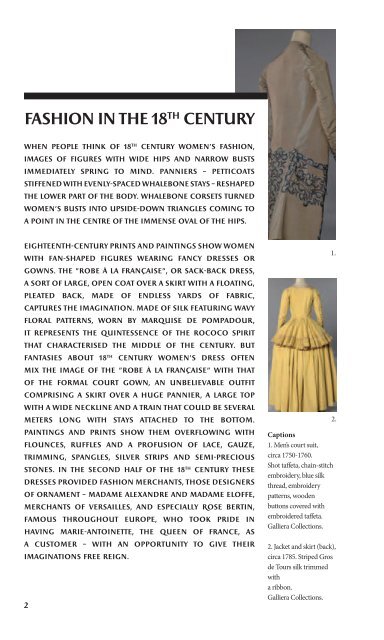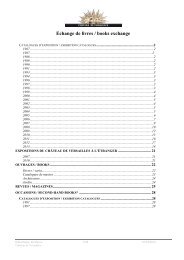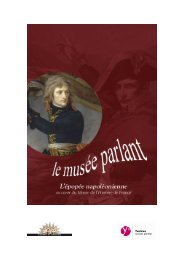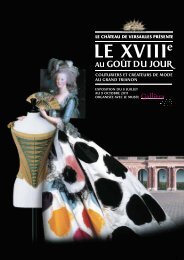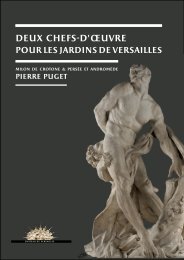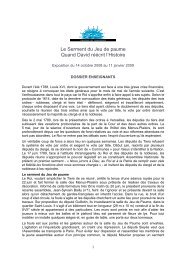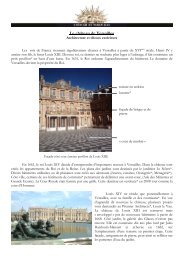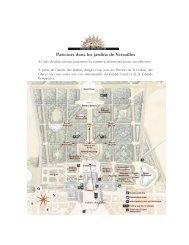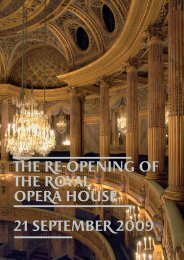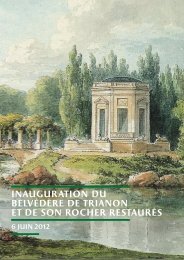The 18th Century Back in Fashion - Château de Versailles
The 18th Century Back in Fashion - Château de Versailles
The 18th Century Back in Fashion - Château de Versailles
You also want an ePaper? Increase the reach of your titles
YUMPU automatically turns print PDFs into web optimized ePapers that Google loves.
fashion <strong>in</strong> the 18 th century<br />
when people th<strong>in</strong>k of 18 th century women’s fashion,<br />
images of figures with wi<strong>de</strong> hips and narrow busts<br />
immediately spr<strong>in</strong>g to m<strong>in</strong>d. panniers – petticoats<br />
stiffened with evenly-spaced whalebone stays – reshaped<br />
the lower part of the body. whalebone corsets turned<br />
women’s busts <strong>in</strong>to upsi<strong>de</strong>-down triangles com<strong>in</strong>g to<br />
a po<strong>in</strong>t <strong>in</strong> the centre of the immense oval of the hips.<br />
eighteenth-century pr<strong>in</strong>ts and pa<strong>in</strong>t<strong>in</strong>gs show women<br />
with fan-shaped figures wear<strong>in</strong>g fancy dresses or<br />
gowns. the "robe à la française", or sack-back dress,<br />
a sort of large, open coat over a skirt with a float<strong>in</strong>g,<br />
pleated back, ma<strong>de</strong> of endless yards of fabric,<br />
captures the imag<strong>in</strong>ation. ma<strong>de</strong> of silk featur<strong>in</strong>g wavy<br />
floral patterns, worn by marquise <strong>de</strong> pompadour,<br />
it represents the qu<strong>in</strong>tessence of the rococo spirit<br />
that characterised the middle of the century. but<br />
fantasies about <strong>18th</strong> century women’s dress often<br />
mix the image of the "robe à la française" with that<br />
of the formal court gown, an unbelievable outfit<br />
compris<strong>in</strong>g a skirt over a huge pannier, a large top<br />
with a wi<strong>de</strong> neckl<strong>in</strong>e and a tra<strong>in</strong> that could be several<br />
meters long with stays attached to the bottom.<br />
pa<strong>in</strong>t<strong>in</strong>gs and pr<strong>in</strong>ts show them overflow<strong>in</strong>g with<br />
flounces, ruffles and a profusion of lace, gauze,<br />
trimm<strong>in</strong>g, spangles, silver strips and semi-precious<br />
stones. <strong>in</strong> the second half of the <strong>18th</strong> century these<br />
dresses provi<strong>de</strong>d fashion merchants, those <strong>de</strong>signers<br />
of ornament – madame alexandre and madame eloffe,<br />
merchants of versailles, and especially Rose bert<strong>in</strong>,<br />
famous throughout europe, who took pri<strong>de</strong> <strong>in</strong><br />
hav<strong>in</strong>g marie-anto<strong>in</strong>ette, the queen of France, as<br />
a customer – with an opportunity to give their<br />
imag<strong>in</strong>ations free reign.<br />
2<br />
1.<br />
2.<br />
Captions<br />
1. Men’s court suit,<br />
circa 1750-1760.<br />
Shot taffeta, cha<strong>in</strong>-stitch<br />
embroi<strong>de</strong>ry, blue silk<br />
thread, embroi<strong>de</strong>ry<br />
patterns, woo<strong>de</strong>n<br />
buttons covered with<br />
embroi<strong>de</strong>red taffeta.<br />
Galliera Collections.<br />
2. Jacket and skirt (back),<br />
circa 1785. Striped Gros<br />
<strong>de</strong> Tours silk trimmed<br />
with<br />
a ribbon.<br />
Galliera Collections.<br />
<strong>in</strong> the late 1770's simplicity started replac<strong>in</strong>g the<br />
pannier’s exaggerated shapes. adjusted dresses with<br />
pleated or hitched-up skirts eclipsed the french court<br />
gown. straight l<strong>in</strong>en or cotton chiffon gowns, an<br />
evocation of l<strong>in</strong>gerie and its <strong>in</strong>timate character,<br />
turned <strong>in</strong>to morn<strong>in</strong>g or afternoon wear. the queen<br />
of France dared to wear percale for her afternoon<br />
outfits. tuckers and ankle-length skirts comprised<br />
negligées for noblewomen and elegant outfits for the<br />
women of humbler means.<br />
men wore "french" suits, which became so popular<br />
they were soon known as "european" suits, ma<strong>de</strong> up<br />
of coats, long-sleeved waistcoats and breeches, which<br />
formed the basic comb<strong>in</strong>ation for centuries to come.<br />
early <strong>in</strong> the century the coats had wi<strong>de</strong> un<strong>de</strong>rskirted<br />
coat-tails, the pannier’s mascul<strong>in</strong>e counterpart, before<br />
mov<strong>in</strong>g <strong>in</strong> the same direction as women’s cloth<strong>in</strong>g<br />
towards a more slen<strong>de</strong>r look. fronts were waisted and<br />
became longer with straight collars. a riot of ref<strong>in</strong>ed<br />
polychrome silk thread embroi<strong>de</strong>ry blossomed on these<br />
coats but the sporty, simple english look’s <strong>in</strong>fluence<br />
tempered that fancifulness <strong>in</strong> the 1780's. solid coats,<br />
military lapels and dark colours counterbalanced<br />
<strong>18th</strong> century exuberance and heral<strong>de</strong>d the follow<strong>in</strong>g<br />
century’s seriousness.<br />
Text based on Pascale Gorguet-Ballesteros' article<br />
<strong>in</strong> the exhibition catalogue.<br />
Captions<br />
3. French court dress,<br />
skirt and stomacher,<br />
circa 1750-1760.<br />
Polychrome figured<br />
silk purl, gold and<br />
silver lamé.<br />
Galliera Collections.<br />
4. Duchess © RMN,<br />
Gérard Blot.<br />
see 18 th century costumes<br />
dialogu<strong>in</strong>g with contemporary mo<strong>de</strong>ls<br />
throughout the "18 th century back<br />
<strong>in</strong> fashion" exhibition.<br />
3.<br />
5. Pair of shoes,<br />
circa 1730.<br />
Leather embroi<strong>de</strong>red<br />
with silver thread.<br />
Galliera Collections.<br />
3<br />
5.<br />
4.


